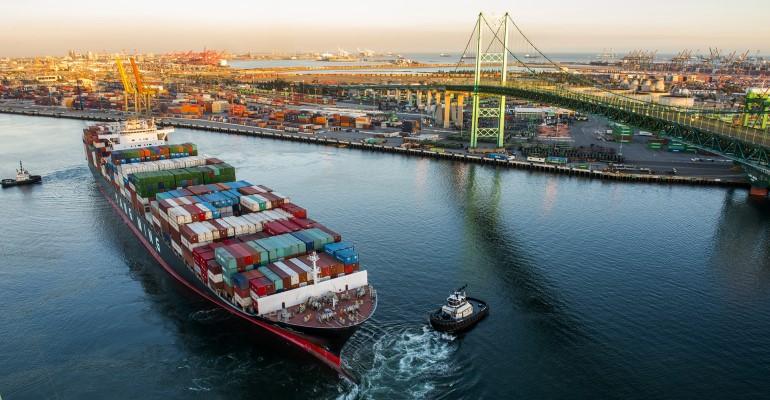Contract setting season is approaching fast and with spot rates influencing contract settlements the battle is on to maintain spot rates at the highest possible level, if you’re a carrier, whilst diminishing the external impacts felt from issues such as the Red Sea crisis, if you’re a shipper.
On that basis Linerlytica’s assertion: “The bullish market sentiment has not been dampened by the Lunar New Year break with carriers still retaining most of their recent rate gains, defying the predictions of a post-holiday correction,” would put the analyst on the carriers’ side of the equation.
According to Linerlytica: “Transpacific eastbound container volumes have rebounded by 16.9% in January 2024 and full year volumes are expected to record positive growth again after falling by 15.1% last year. Transpacific carriers have been able to take advantage of the strong cargo rebound with freight rates more than 200% higher compared to last year.”
Xenata’s chief analyst Peter Sand disagrees with that analysis: “What we see going into March is carriers are pushing for GRI to get implemented, that would lift rates - as of now, they don't seem to be very successful in doing that.”
Xenata point to a Pacific peak early in February and a slide in rates since, even though Sand concedes that rate levels eastbound on the Pacific are currently at $4,700 per feu to the Westcoast, an 18-month high.
“Long term rates are up by 25% since end-September 2023. Carriers appears to be a in comfortable position - as compared to anything - but specifically due to Red Sea disruption,” said Sand.
Questions from Seatrade Maritime News to Linerlytica on their forecast saw the company row back to a certain extent. “We are not suggesting that freight rates are not going to fall. A post-holiday correction is certainly to be expected, but the key question is how sharp will the drop be and for how long?
“At this point, rates are still holding up relatively well and the Red Sea diversions will keep capacity tight at least for the next three months,” said a Linerlytica spokesperson.
According to Linerlytica new capacity will add 8.9% to the supply side of the market, “spread over 12 months, and with carriers’ ability to manage capacity through delaying arrivals back to Asia, this will “limit the anticipated rate correction”.
That scenario is certainly being played out on the Asia - Europe trades with one freight forwarder arguing that carriers have cut sailings to manage capacity, but also some carriers are still suffering from scheduling challenges as a result of the diversion around the African Cape.
“In the eight days between 15 and 23 March THE Alliance are expecting four vessels to arrive at Southampton from Asia, with a two-day turnaround these ships will be serviced back-to-back,” said the forwarder.
He went on to say that Ocean Alliance vessels had already successfully managed the diversion with ships arriving slightly late, but at the rate of once a week.
As a result, even with this ability to manage capacity James Hookham, director at the Global Shippers’ Forum, believes there is “no fundamental pressure on rates”.
He added that his members are not talking about rates increasing at the moment, but rather that the situation has plateaued, and even peak season surcharges have moderated, which was also alluded to by the forwarder.
Hookham did warn shippers and forwarders to consider their options in fixing contracts because there is a belief that should carriers resume sailing via Suez, then contracts could leave shippers paying more.
“Shippers should consider only signing three-month deals or adding a ‘return to Suez rate’ to the contract to cover this eventuality,” said Hookham.
One of the key moments for the industry could be the mood when the contract season on the Pacific begins in earnest, in early March, with rates on these trades also affected by the continuing Red Sea crisis.
“January supply estimates have gone up by 6.8% year-on-year, we have no solid numbers on demand for January yet - but if we go with 16.9% you would still not see demand higher than 2021 and 2022, and January '23 was at least a five-year low point,” argues Sand.
Again, Linerlytica appears to row back a little on its original statement: “We are not suggesting that Transpacific demand will see significant growth this year, but just to highlight that the worst of the correction is over and we are looking at positive growth again. This, together with the increased teu-mile demand due to the Red Sea diversions, will provide support for freight rates.”
Drewry argues that unlike some analysts it deals in facts based on the early annual contract bids, which Drewry runs for global shippers: “According to our Container Capacity Insight reports, between Feb and March, there will be a 14% rise in Asia-West Coast North America capacity, caused largely by a large reduction in cancelled sailings from 44 to 26 a month.”
Even so Drewry does see some increase in demand, which will mean that utilisation remains largely the same, at a very high rate, therefore supporting, “a small increase in spot rates between Feb and March.”
However, Drewry considers that contract rates for the first half of 2024 will only show small increases from a year earlier.
“Contracts for many shippers starting from May 1 or June 1 will reflect some small year-on-year increases in the second half of 2024, having experienced reductions between 1H23 and 1H24,” concluded Drewry.
Copyright © 2024. All rights reserved. Seatrade, a trading name of Informa Markets (UK) Limited.
Add Seatrade Maritime News to your Google News feed.  |

